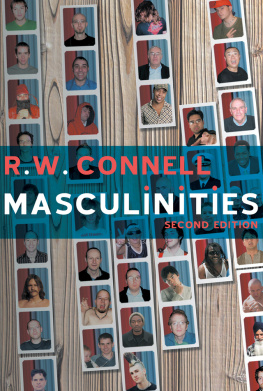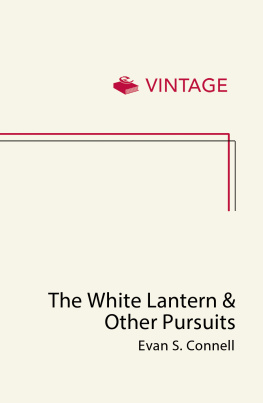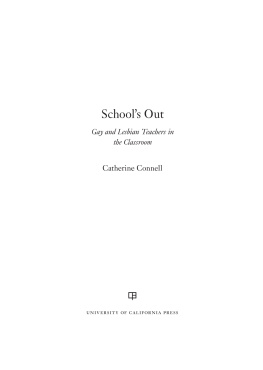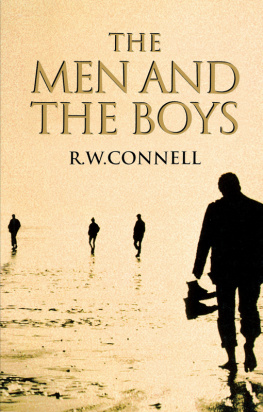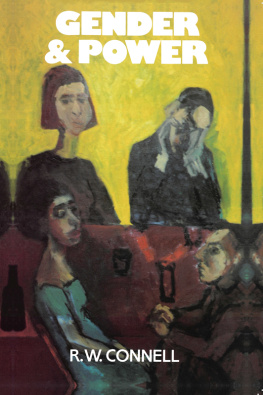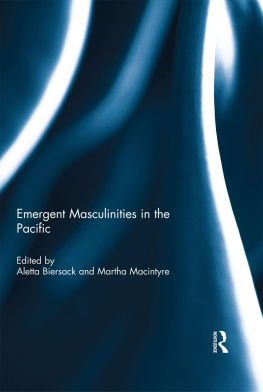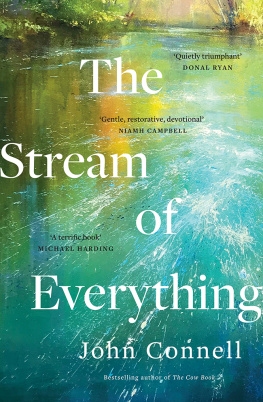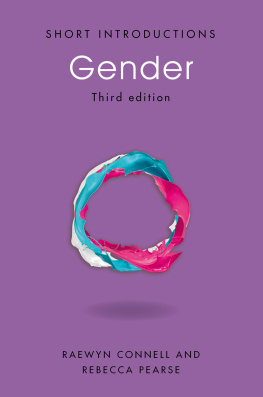Connell - Masculinities
Here you can read online Connell - Masculinities full text of the book (entire story) in english for free. Download pdf and epub, get meaning, cover and reviews about this ebook. year: 2005, publisher: Taylor and Francis, genre: Romance novel. Description of the work, (preface) as well as reviews are available. Best literature library LitArk.com created for fans of good reading and offers a wide selection of genres:
Romance novel
Science fiction
Adventure
Detective
Science
History
Home and family
Prose
Art
Politics
Computer
Non-fiction
Religion
Business
Children
Humor
Choose a favorite category and find really read worthwhile books. Enjoy immersion in the world of imagination, feel the emotions of the characters or learn something new for yourself, make an fascinating discovery.
- Book:Masculinities
- Author:
- Publisher:Taylor and Francis
- Genre:
- Year:2005
- Rating:4 / 5
- Favourites:Add to favourites
- Your mark:
- 80
- 1
- 2
- 3
- 4
- 5
Masculinities: summary, description and annotation
We offer to read an annotation, description, summary or preface (depends on what the author of the book "Masculinities" wrote himself). If you haven't found the necessary information about the book — write in the comments, we will try to find it.
Masculinities — read online for free the complete book (whole text) full work
Below is the text of the book, divided by pages. System saving the place of the last page read, allows you to conveniently read the book "Masculinities" online for free, without having to search again every time where you left off. Put a bookmark, and you can go to the page where you finished reading at any time.
Font size:
Interval:
Bookmark:

MASCULINITIES
R. W.Connell
SecondEdition

First published 1995 by Allen & Unwin
This edition published in Australia and New Zealand in 2005
Published 2020 by Routledge
2 Park Square, Milton Park, Abingdon, Oxon OX14 4RN
605 Third Avenue, New York, NY 10017
Routledge is an imprint of the Taylor & Francis Group, an informa business
Copyright R.W Connell 1995, 2005
All rights reserved. No part of this book may be reprinted or reproduced or utilised in any form or by any electronic, mechanical, or other means, now known or hereafter invented, including photocopying and recording, or in any information storage or retrieval system, without permission in writing from the publishers.
Notice:
Product or corporate names may be trademarks or registered trademarks, and are used only for identification and explanation without intent to infringe.
National Library of Australia
Cataloguing-in-Publication entry:
Connell, R. W. (Robert William), 1944- .
Masculinities.
2nd ed.
Includes index.
ISBN 1 74114 519 8.
1. Masculinity. 2. Sex role. I. Title.
155.332
Set in 11/12 pt Baskerville
ISBN-13: 9781741145199 (hbk)
Even for a practised writer, this book has been difficult to write. The issues are explosive and tangled, the chances of going astray are good. The support I was given made the difference. The advice and love of Pam Benton and Kylie Benton-Connell were vital at the time of the first edition. Pam did not live to see the second; Kylies support has continued, and has made my later work possible.
Norm Radican and Pip Martin worked as interviewers for the study reported in , and I learnt a great deal from them. Mark Davis was research assistant on a later interview project that influenced my view of class and sexuality. I am grateful for the extensive typing done by Marie OBrien, Yvonne Roberts and Alice Mellian. Major funding for the research was provided by the Australian Research Grants Committee, and supplementary funding by Macquarie University, Harvard University, and the University of California at Santa Cruz.
I would like to acknowledge the friendship and intellectual contribution of colleagues, especially Mike Donaldson, Gary Dowsett, ystein Holter, Heinz Kindler, Ilse Lenz, Jim Messerschmidt, Mike Messner, Ulla Mller, Rosemary Pringle, Lynne Segal, Barrie Thorne, Steve Tomsen and Linley Walker. They are among the makers of the new era in gender research; I hope their work and mine contribute to a new era in practice.
Parts of this book have previously appeared in different formats. They are: the section on clinical knowledge in as The big picture: masculinities in recent world history, Theory and Society, 1993, vol. 22, no. 5; part of the Introduction in Masculinities, change and conflict in global society: thinking about the future of mens studies, Journal of Mens Studies, 2003, vol. 11, no. 3; part of the Afterword in Scrambling in the ruins of patriarchy: neo-liberalism and mens divided interests in gender change, in Ursula Pasero, ed., Gender from Costs to Benefits, Westdeutscher Verlag, 2003. I am grateful to these publishers and journals for permission to reproduce this material.
It is now ten years since the first edition of Masculinities was published. In the meantime a great deal of research, public debate and policy-making has occurred. In the new edition, while keeping the original text unchanged, I also describe the new work and discuss the meaning of this field of knowledge as a whole. In this Introduction I sketch the origins of the book, and discuss in greater detail the research that has been done since it appeared. In the Afterword I trace recent debates about the politics of masculinities, and discuss the implications of masculinity research for understanding current world issues.
Masculinities tries to do five things within a single conceptual framework:
- trace the history of the modern Western investigation of masculinity ();
- present a theory of masculinities, embedded in a social theory of gender ();
- describe the lives of four groups of men caught up in processes of change ();
- synthesize the history of Western masculinities and their political expressions ();
- propose strategies for the politics of gender equality ().
The book had multiple origins, and rests, like all social science, on the contributions of many people besides the author. A debate about men and gender had taken off in the wake of the Womens Liberation movement; there was even a small Mens Liberation movement in the 1970s that attempted to reform the male sex role. This gave rise to interesting political discussions about men, power and change. But it did not immediately produce much research about what men and boys actually do, and it suffered from deep conceptual confusions about gender.
In the late 1970s I was one of a research group making a study of inequalities in education. This involved an empirical study of social relations in secondary schools, in the course of which we identified multiple patterns of masculinity and femininity among teenagers (Connell, Ashenden, Kessler and Dowsett 1982). In the early 1980s I was involved in a conceptual project with two men who were both gay activists and theoreticians, which produced an outline for a new sociology of masculinity (Carrigan, Connell and Lee 1985). I was soon also involved in a program of research on social dimensions of AIDS, mainly in the context of gay mens lives. This led to some hard thinking about theories of sexuality as well as the shape of connections among men (Connell and Dowsett 1992, Kippax, Connell, Dowsett and Crawford 1993).
In the mid-1980s I was concerned about the lack of empirical knowledge about masculinities, and so launched a study of the gender practices and consciousness of men in circumstances of change, using life-history interviews. I conducted this with the assistance of Norm Radican and Pip Martin, and in due course it became the basis of 7 of Masculinities.
In a broader sense, the book grew out of theoretical work on gender as a social structure. I had been trying for years to formulate an integrated social-scientific account of gender relations, and eventually got this together in Gender and Power (1987). This analysis showed there were bound to be multiple masculinities, and more or less demanded that I should fill in the blanks about them. In turn, this theoretical work on gender grew out of my encounter with feminism especially in the life and work of my wife and partner Pam Benton. She made it clear that issues about gender were never just contemplative, but always had to do with social action.
So the threads came together. But I was reluctant to weave them into a book, because there was already a genre of books about men that had become hugely popular. This was a mixture of pop psychology, amateur history and ill-tempered mythmaking, and I hated it. Backward-looking, self-centred stereotypes of masculinity were the last things we needed. I didnt want to reinforce the imaginary identity of men that was created by the very existence of this genre of books.
Eventually I became persuaded that a book documenting and explaining the diversity of gender patterns among men was worthwhile. We might drive out some of the bad coin with good. It wasnt easy to write. I dated the preface June 1994, which was two months after Pam began her long battle with cancer. Since I started work on the book, our family had moved house internationally three times, I had taught in three universities in two countries, and our daughter Kylie had been in four different schools. For all the turbulence of its writing, however, there is a consistent approach running through all the sections, and that is perhaps what has given the book its impact.
Font size:
Interval:
Bookmark:
Similar books «Masculinities»
Look at similar books to Masculinities. We have selected literature similar in name and meaning in the hope of providing readers with more options to find new, interesting, not yet read works.
Discussion, reviews of the book Masculinities and just readers' own opinions. Leave your comments, write what you think about the work, its meaning or the main characters. Specify what exactly you liked and what you didn't like, and why you think so.

